October 2011
Hrvatska to BiH Redux
Still Fun the Second Time Around
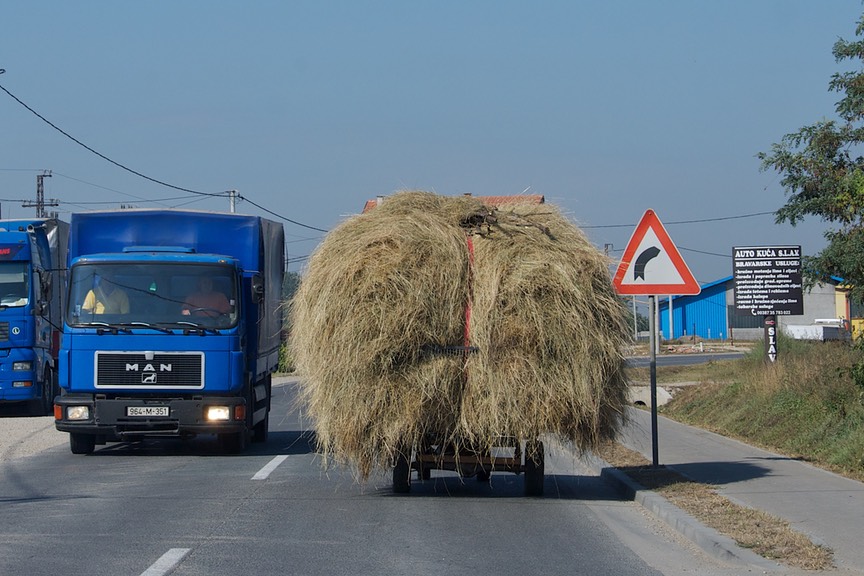
Well now, if you’re at all able to keep track (definitely worth a gold star), you know we left Bulgaria mid-September, moving west. We trucked on through Serbia, and we’ve shared with you how much we enjoyed that country, particularly its monasteries. And now, with our faces basking in the afternoon sun, we’ve been bouncing back and forth between Croatia (Hrvatska) and Bosnia (BiH), as we have traveled all the way to the Adriatic and western Croatia, and then south along the Dalmatian coast. Our goal was to see these coastal areas after the tourist rush was over and we largely succeeded. Although we didn’t see too much that was new to us, we found several intriguing spots along the way, as well as some lovely scenery.
In picking a route west, we had the choice of traveling across northern Bosnia, which we had largely done before, or taking the toll road across eastern Croatia, which we had thoroughly explored already. Neither option was particularly attractive, but other alternatives were too far out of the way to be considered. Strongly desirous of a good road and a quick trip, Rick was quite interested in the toll road. However, there were cities we wanted to visit that wouldn’t happen if we chose that route, and we feared the toll road would be expensive. A positive of the Bosnia route is that BiH has the cheapest fuel around, while the biggest downside is that Emily is her own little United Nations, and she doesn’t recognize Bosnia. When she gets there, she greets us every morning with a mostly blank screen.
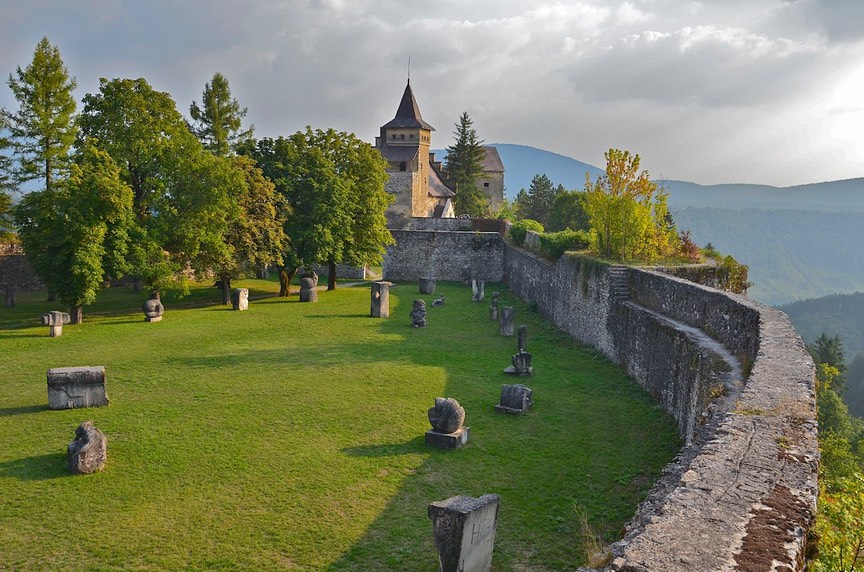
Ultimately we chose to truck across the (lousy) roads of northern Bosnia, and said Ciao to Emily at the border. We traveled a route further north than the one we’d used earlier in the summer; the trees were turning, and we got a new look at some familiar countryside. We still could buy watermelon beside the road – the best watermelon we’ve ever had. No more roadside peaches, but now there were delicious pears, and eventually we entered a pomegranate-growing region.
It was a quiet trip to the coast. We were able to visit national parks all by ourselves, as well as the very pretty Una River Valley, reportedly so named by the Romans as being number one in their book. Well worth the detour we took to get there, with quiet, still waters meandering through a lovely area. Nearing the border, we stopped in Ostrožac to see the fortress. Maybe shouldn’t have bothered, as it was even more out of our way; but the ruins were very atmospheric, we had the late afternoon sunshine all to ourselves and spent a quiet night parked right up against the walls; sufficiente.
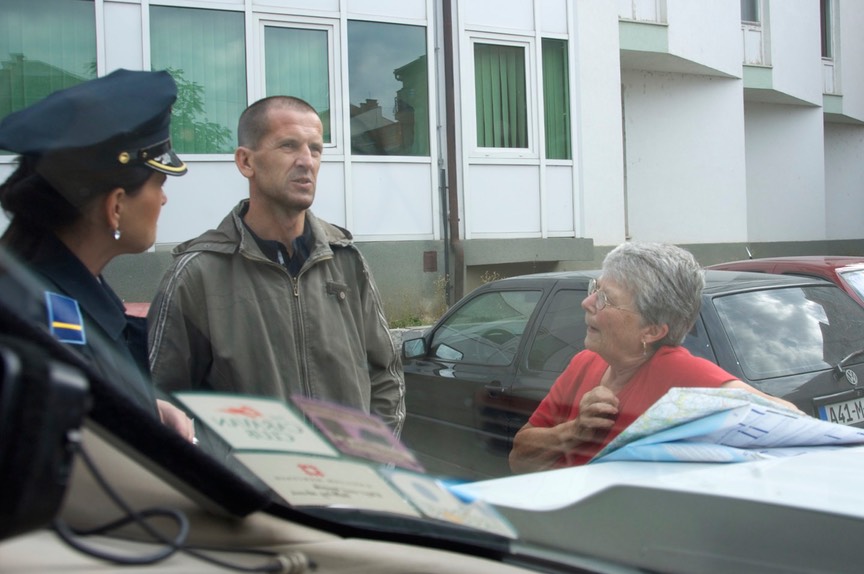
Then we got lost – such a mess! The maps just aren’t that good, you know, and we really do miss Emily when she abandons us. The next town on “our” road was Cazin, so we wanted to get through there and then reach the border. Well, we were in Cazin, lost, and didn’t know it. Following poor signage, we had ended up in the middle of town, which was like all torn up. Like total chaos! Someone pointed us down “that way” and we found ourselves in the middle of a parking lot completely filled with cars and no exit. No way to turn around. And here comes the police – a very tall, extremely lovely woman of about 30 who was very unhappy with us.
She was very good at her job. She made folks get into their cars and get the hell out of our way. She got us turned around. She got another police officer to get in his car and lead us out of town. And… eventually she even softened and smiled. She asked us where we were from, and when we said “California” her whole face lit up, she asked us if she could come with us, and it all turned into a joyful moment. Definitely worth the hassle.
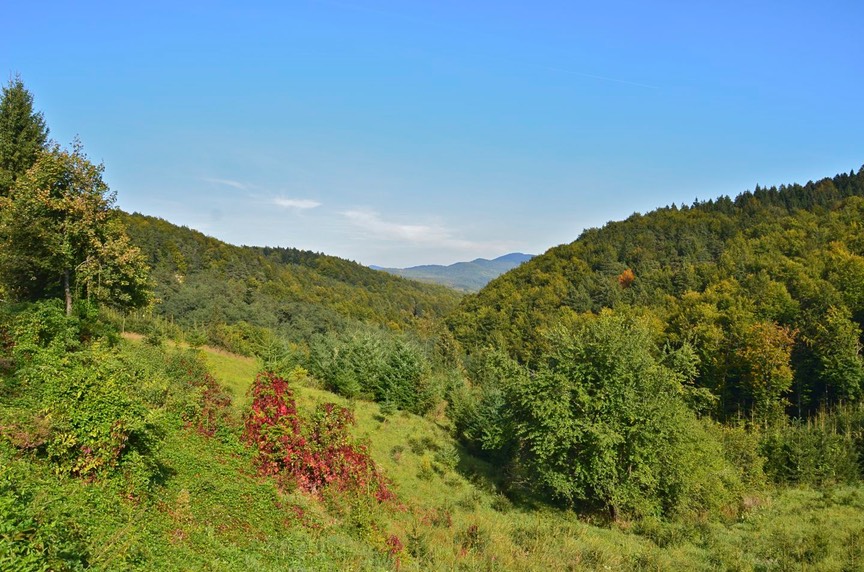
Finally on our way again, we reached the Croatian border – and immediately got into trouble again. We started out by going in the wrong way. When we got turned around and pulled up to the booth, we were promptly told we had to go back and start over again. It’s a new crossing, with new equipment we’d not seen before. No signage, of course, but apparently we were supposed to pass between two posts way off in a corner of this huge area (probably an x-ray camera there somewhere).
All that handled, we pulled up to the booth again, and Rick started having fun with the border guys. They all piled out of their booths (both BiH and Croatia sides were together at this crossing) and were looking at the stickers on the truck. One BiH guy couldn’t find “their” sticker and Rick had to help him out. Then he was happy, we got our passports stamped, moved three feet into Croatia and got stamped in there, and were on our way with waves and smiles. Such hoop-la!
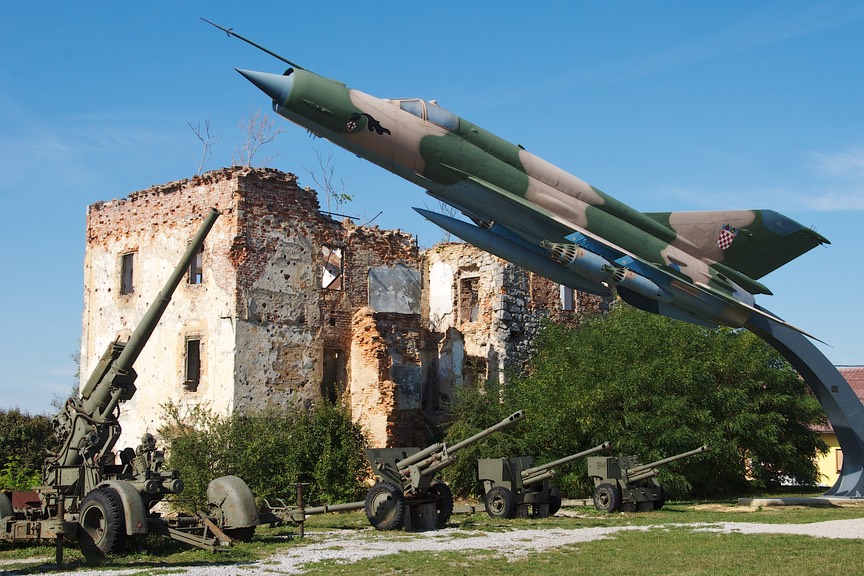
So! We were back; Emily woke up and rejoined us; the roads were better and we finally had plenty of recycling again. ‘Bout time; my bag was overflowing.
We’d landed sort of near where the Croatian boomerang bends in the middle, and headed west. Our first stop was near Karlovac, at the Turanj museum of the 90’s war, here referred to as the Homeland War, where we looked at tanks and airplanes, along with some excellent sign boards in both Croatian and English giving a timeline of the war from the Croatian point of view. They had some good information, and some nifty tanks (an oxymoron if I ever heard one), including a single WWII US Army Sherman tank that had been taken out of mothball storage to be added to the local arsenal.
Then we were off to the coast. Western Croatia is very different. More developed and modern in general, with more services and more people. Nice, although we quickly began missing the rural areas we’d enjoyed so much further east. We managed to maneuver ourselves through Rijeka, a huge city and the bottleneck in “the bend”, then over Učka Mountain on a tiny, tiny road to avoid the toll tunnel (we do have our principles, after all). It’s now October 1st and fall continues to grace us with lovely clear, cool days.
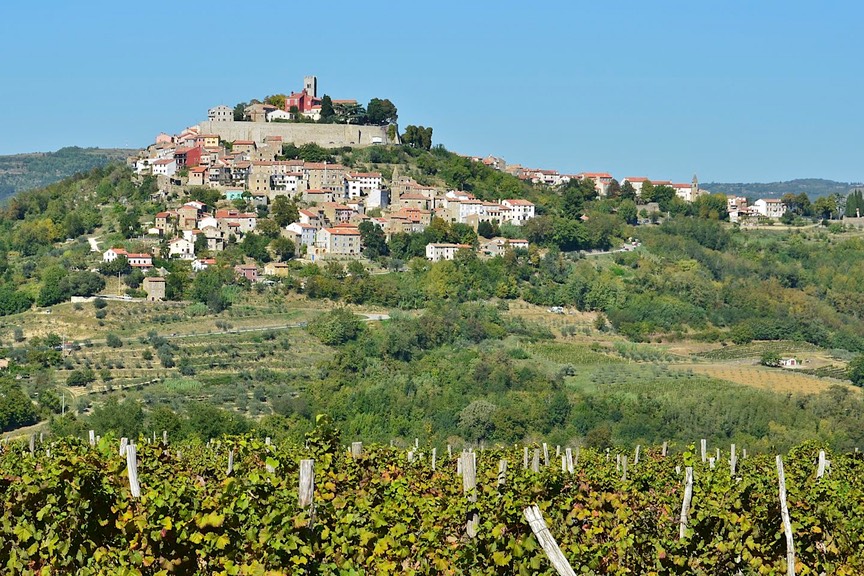
So there we were on the Istrian Peninsula, the Croatian Italy. Hill towns everywhere. They were as charming as advertised, and we saw as many as we could, all looking like they belonged on the other side of the Adriatic. We stopped to check out the village of Roč, a pretty little place with Glagolitic connections. Glago-what you ask? The Glagolitic language was developed by Byzantine monks in the 9th century because it was closer to the Slavic languages of the people they were trying to convert. It caught on and was in evidence well into the 1800s, and there are surviving missals to be seen. (The Cyrillic alphabet still in use is a modified version of the Glagolitic script.) At some point in the 1970s the locals erected a bunch of monuments to commemorate the language; some of them are still around and they’re kinda cool, if a little hokey.
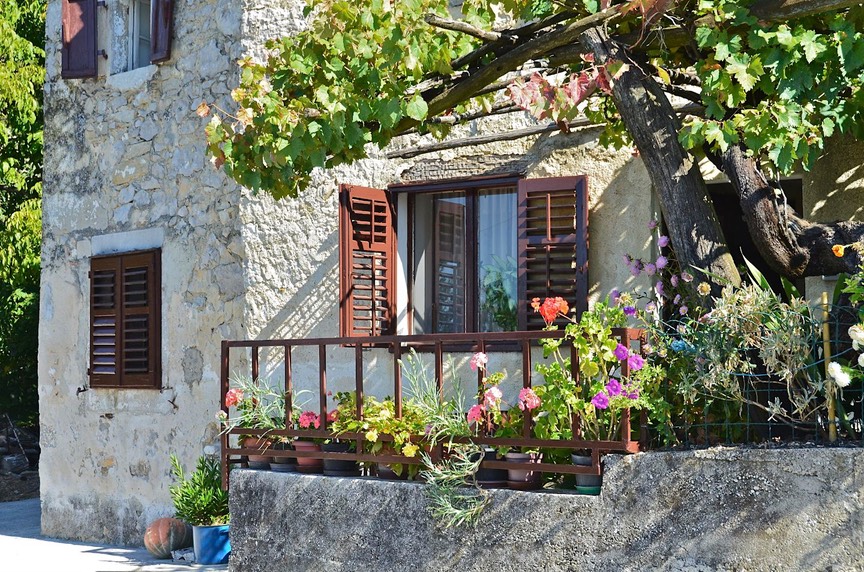
Probably our favorite of the hill towns was Sovinjak, very cool and tiny and very Mediterranean; olives and grapes, and huge old trees hanging over the houses. We didn’t go into nearby (and well recommended) Motovun, due to their $10 parking/bus fee, basically an entry fee for the town, but dipped our hats to Mario Andretti as we passed; he’s their favorite son, and no, that doesn’t mean he’s really Croatian; at that time this area was indeed part of Italy.
When we got to the west coast of the peninsula, it got much more touristy, although still charming. Poreč was our favorite town in this area; probably a zoo in August, but lovely on an October Sunday morning. It was terrific and rather small, with a cool basilica we were able to crawl all over. We also spent some time in Pula, regional center of the area and a very popular spot. We thought it was fun, with an absolutely splendid Roman coliseum, but too full of folks and souvenir shops. Pula did, however, provide us with a lovely overnight spot along a quiet lagoon (thanks again, Roy and Kathy) and – a wonderful surprise – several Mexican restaurants. Si, Señor, mas fajitas por favor!
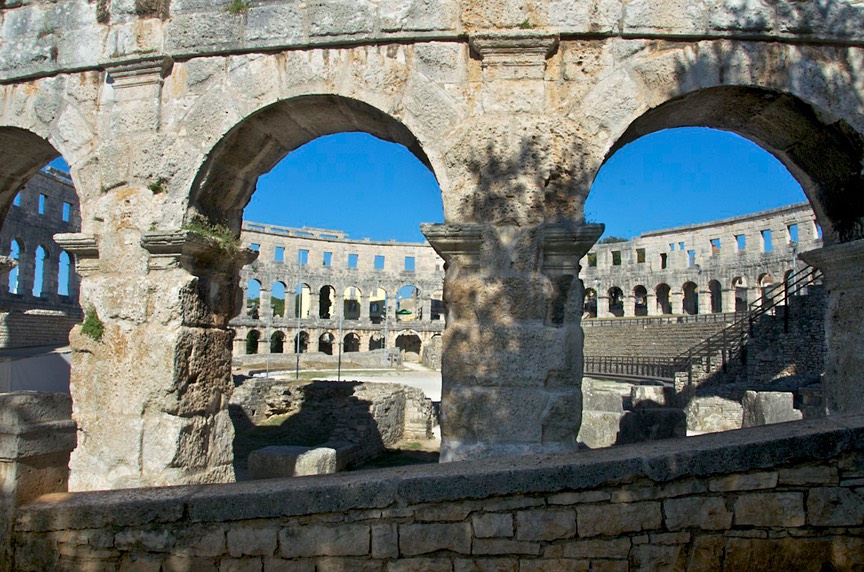
Istria is a huge tourist area, but we enjoyed it very much. Away from the big spots and where the cruise folks go, there are the same modest farmhouses and barns and fields of corn we are so fond of. The hill towns, unless they’re one of the famous ones for any reason, are quiet and lovely, and life is slow.
But we wanted to keep going. So on we went, to the Dalmatian Coast, our goal for the last several months. Sadly, we were somewhat disappointed. Traveling south along the coastline, we visited several pretty towns, but even this late in the year there were so many folks around, and cruise ships hovering just a ways out to sea, and glitter and tourism everywhere. Some of the towns were a little disappointing, very posh and expensive with little to show for it. We felt that Trogir was one of these; too pretty, too clean, full of sidewalk restaurants and chic. Trogir does have a pretty neat small cathedral though, with the best critters at the entrance we’d ever seen. Unfortunately, you have to pay too much to go in and the whole interior was torn up for cleaning or restoration or something. Cool lions though.
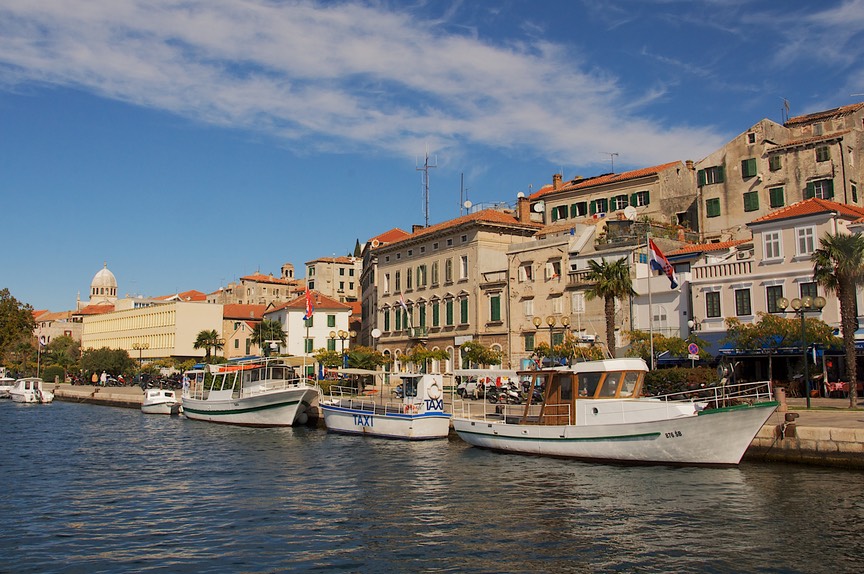
But we had a terrific time in Šibenik. It has no deep water port, so the cruisees don’t clutter it up. It had nifty sites to visit, and a nice sense of itself as a real place, not somewhere created for the tourists, and it was a good walking city. We highly recommend it as a destination. We think you’ll love it.
Another town worthy of a recommendation was Zadar. It’s not as interesting as Šibenik, but it’s a university town, so it’s livelier and has a different feel to it. The Byzantine baptistery there is supposed to be a real treat. When we visited it, they were doing an architectural dig and so the entire area was closed off. But it was lovely, sitting there in the midst of all the turmoil. And, outstandingly, Zadar has an honest to goodness In n Out Burger! Who Knew?? Would you believe that? The burgers were a lot like at home, but bigger and much juicier. It was just a little hole in the wall walk-up place, but the signage was the real deal and the food was good. You’d have to see it to believe it.
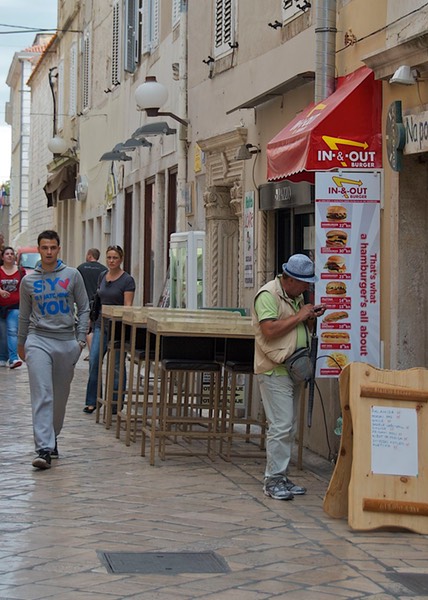
The Dalmatian coastline itself is rocky and bleak, not very interesting. Folks seem entranced by its beauty, but we had trouble seeing what the big deal was; maybe we’ve spent too many years in California, going up and down Highway One. Also, this coast has been a tourist mecca for more than a hundred years, and resorts and marinas are everywhere, along with lots of campgrounds with storage yards filled with caravans, although there still are a fair number of motorhomes on the road.
If you are familiar with this area, you know that the biggest draw of all is the wonderful old city of Dubrovnik. But if you have looked at the map, you know you can’t just drive on down the coast until you get there. Another country sticks its foot out and trips you up: Bosnia. At some point BiH was granted a few feet of coastline in order to give it sea access. So, you enter and leave BiH and then go on down to D-town.
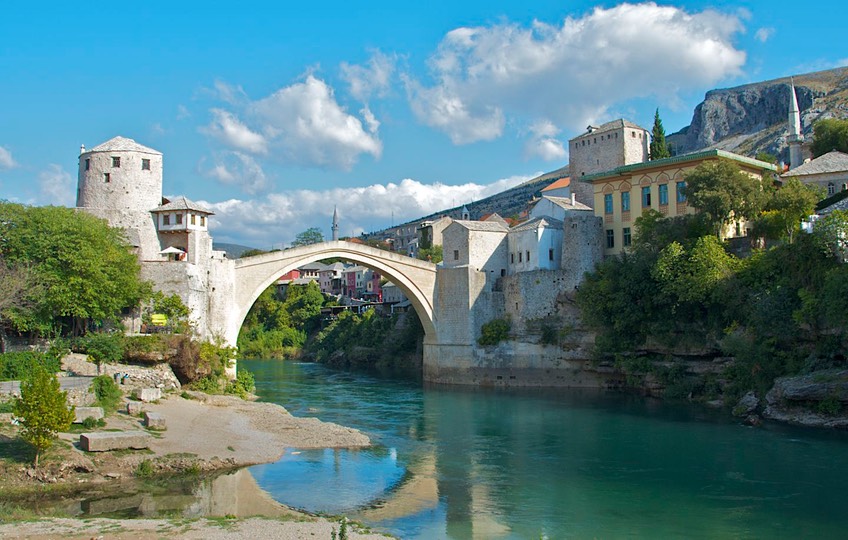
But most folks, if they have the chance, take a few moments and duck inland to see the city of Mostar and its famous bridge. We did, and it was well worth it. Had to check Emily at the border again, of course. We picked a tiny, quiet border crossing that was a little north of where most folks would enter; instantly we were back into an area where cabbage and squash and pomegranates were for sale beside the road, the crops had been plowed under in the fields, and the leaves were turning on the grapevines. It was a nice valley, very rural, just over the mountains from the shining Croatia coastline. An amazing difference.
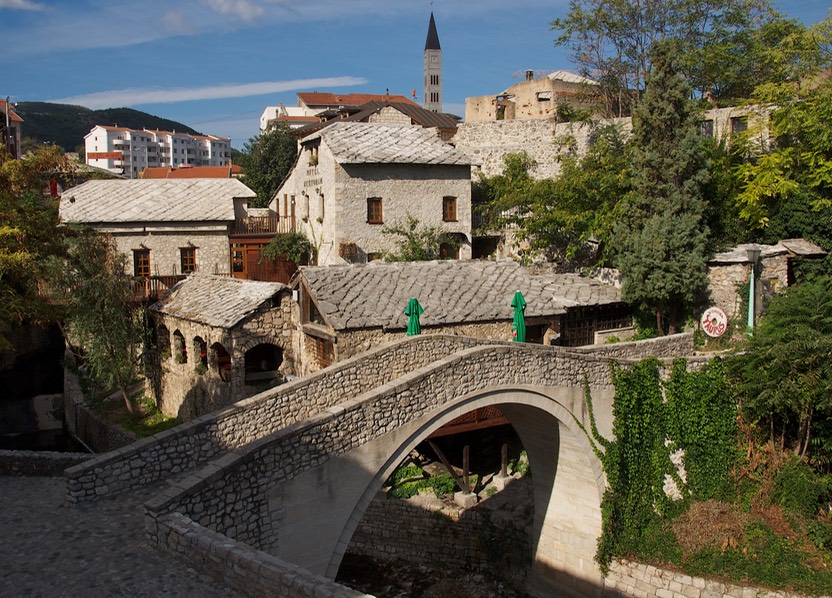
We explored this tiny triangle at the bottom of BiH for a couple of days. Heading toward Mostar, we followed its river inland, up a pretty canyon past the Dervish Monastery at Blagaj. It sounded intriguing, but, although it was in a great setting, with the monastery built right beside a cave from which was issuing this pretty river, it was tacky and becoming very touristy. But it was a lovely spot.
Mostar was great. Rebuilt after being mostly destroyed in the 90s, it was much too clean. But the setting is incredible and the feeling is super; we had a great visit. The bridge had stood for 427 years, so its destruction in 1992 was a real tragedy. There is a nice old area around the bridge, although the rest of the town is still getting back to itself. After the war, Mostar received lots of help worldwide; we saw signs talking about Norway and Luxemburg, for instance. It’s a treat; expensive, but all these places are; too close to Croatia and largely supported by day-tripping cruisers. You learn to ignore them and step aside as each group troops by; they never stay in any one place for long.
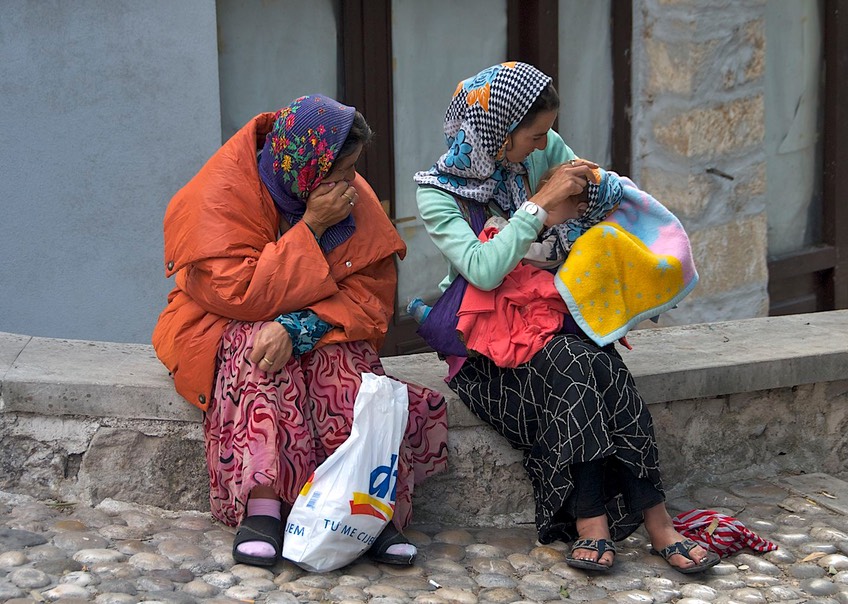
Moving further south in this triangular area, again we saw signs warning of unexploded mines, and much of the area was quite inhospitable, rocky and barren. We had one final stop in mind in this area, Trebinje. We were glad we paused there, even if we didn’t stay long. We think it would have been charming earlier in the season. It’s late in the year here now, and almost wintery feeling; we do recommend it for a stop, but come in the summer. This area saw a lot of action in the war, and these folks were quite involved in the bombing of Dubrovnik. Apparently some nasty feelings still exist between the two cities. But the locals are lovely people, and it’s nice countryside, with lovely lush vineyards. For the first time we saw limes at the outdoor markets; we really are much further south.
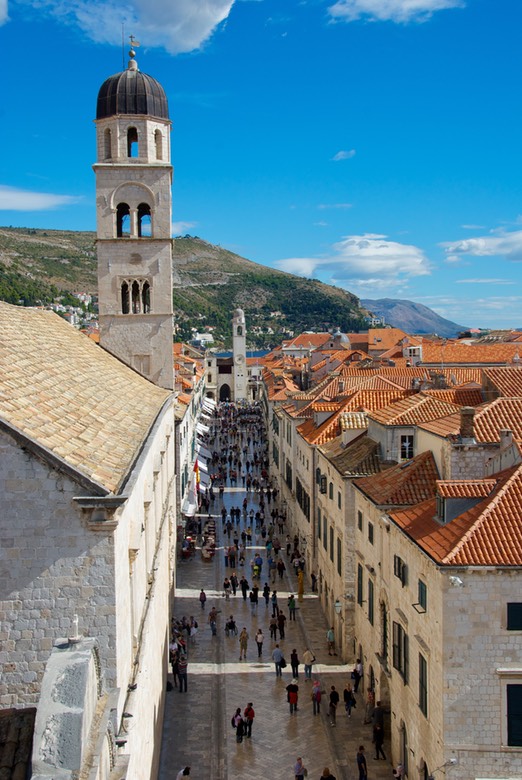
We climbed back over the mountains to the border, passing through tiny Hum, a mostly abandoned village in barren and rocky terrain, with both destroyed and rebuilt houses next door to each other. Lots of bullet holes around.
Then, suddenly, we were in Dubrovnik. Our visit was great, worth every single bit of our huge struggle to find a place to park. It was a beautiful day, and the coast was obviously at its best. One of the things you can do in this city is to walk the walls of the old fortress; they circle the entire old town. Walking along the walls is a real treat. You can see the coastline, but that’s not the best part. You also can see the entire old town, from above. It’s a unique opportunity to see what the top of a cathedral looks like – to enjoy the relationships between various buildings – to see where tiny streets and alleys go – it was just great. There was a cruise ship in town, which was a slight disappointment, but Dubrovnik is a big city. We had a ball.
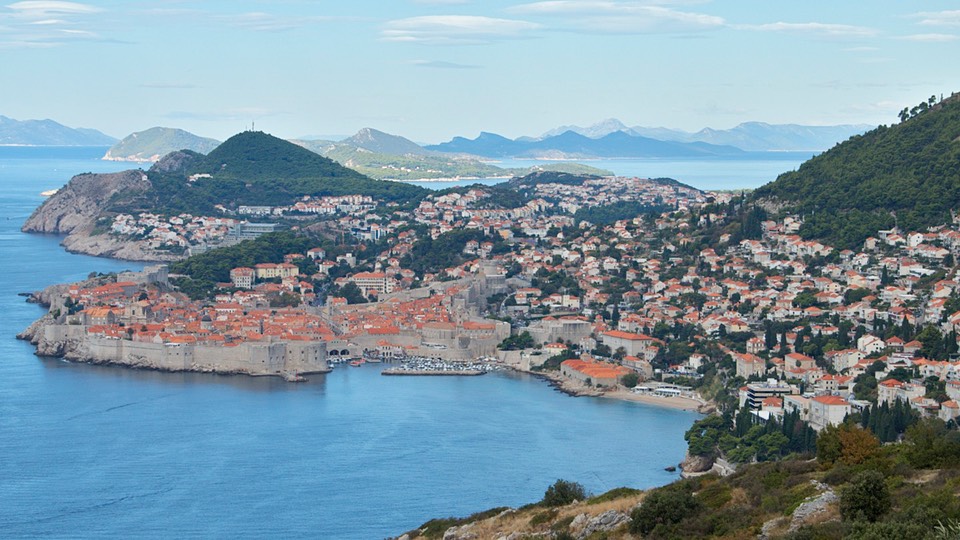
We should probably explain our comments regarding cruise ships lest we give offense to anyone. Cruising is a wonderful way to travel and many of our friends enjoy it very much, so our comments are certainly not intended as any criticism of individual travelers. Rather, the issue is the effect that cruise ships have on their ports of call, which is considerable. Take Dubrovnik as a case in point. It is an incredibly beautiful medieval city in a fabulous coastal setting. To gaze on it from the hills above is to be mesmerized. Once you enter the city, however, things change. The buildings are still lovely, but you quickly realize that for the most part, things aren’t really real. It’s as though you’ve entered a shopping and dining theme park where everything has been brought in to cater to the throngs of visitors. In fact, drop the “as though”; that is exactly what you’ve done. While the old buildings still work their magic, for the most part they are now filled with stores offering every conceivable modern amenity, but which have little to do with a trip to a foreign country.
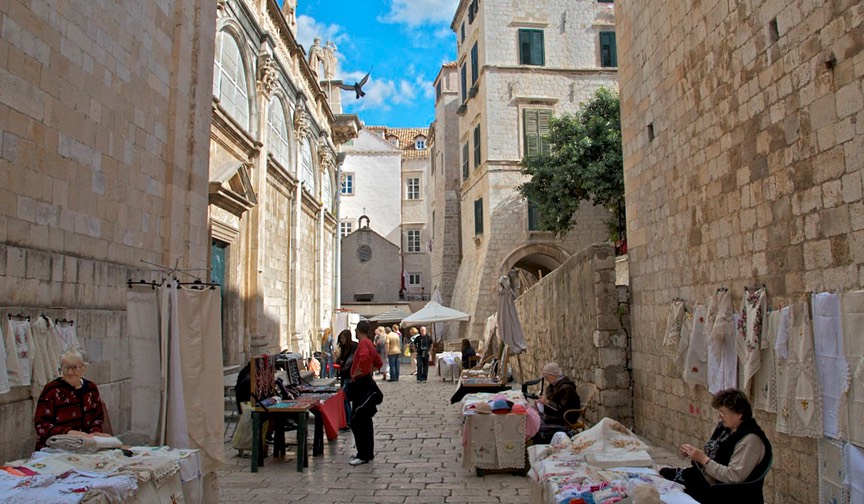
Now, this is not necessarily a bad thing, and we applaud anyone who has made the effort to travel to a foreign port and to see a part of the world that is different from their own homeland. For us, the impact is in the differences between the experiences being had by these folks and the ones we are fortunate enough to enjoy as we travel to places that are not on the itinerary of cruise ships or other forms of package tourism. We saw no cabbages for sale in Dubrovnik, and encountered no donkey carts in the streets. The many poignant and fascinating scenes we have in our memories from visits to small villages throughout the Balkan states will not show up in the photo collections of the cruise ship and tour bus travelers; and that’s too bad. If you do come to Dubrovnik though, don’t miss the walk around the old walls; it’s a real ‘E’ ticket ride for sure.
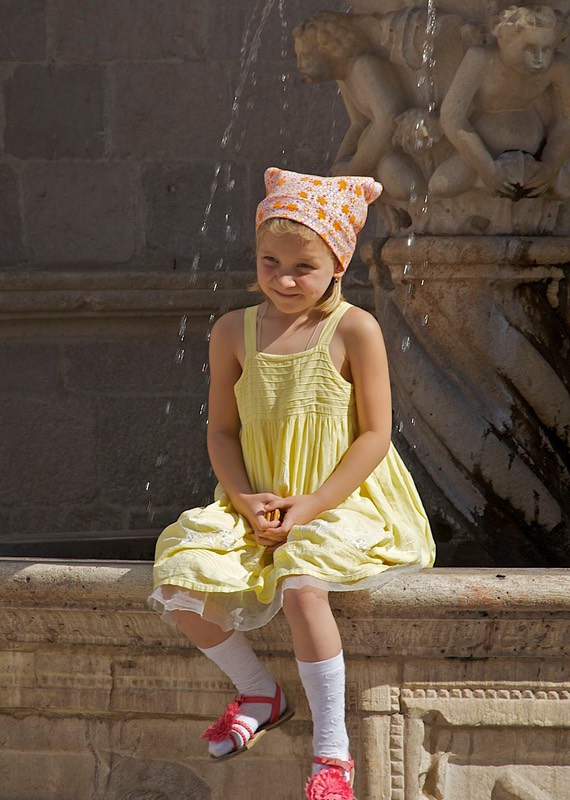
We spent one last night in Croatia, in a lovely valley of vineyards near Gruda, close to the border. It was close enough to Dubrovnik to be upscale, but we found a spot for ourselves tucked back in a quiet corner next to a community activity center. We shared the football field with a burro and a pretty little pinto pony. The next day we crossed into Montenegro.
We’re moving along, but before we leave you now, we have an exquisite moment to share, compliments of one of our favorite playwrights and filmmakers, David Mamet. It’s a scene from his wonderful movie, State and Main. A bemused Phillip Seymour Hoffman is speaking to a sparkling Rebecca Pigeon.
Did you ever wonder why the Dalmatian’s the symbol of the firehouse?
The first organized fire department was on the border of Dalmatia and Sardinia in the year 642.
That’s why the Dalmatian!
It was either that or a sardine.
Be well, and stay in touch. Rick & Kathy, along with Emily (usually) and the Tiger (always)
ps: we do realize that Sardinia is an island and therefore cannot share a border with anyplace else, but it makes a cute line anyway.
Click to see more photos from Bosnia and Croatia